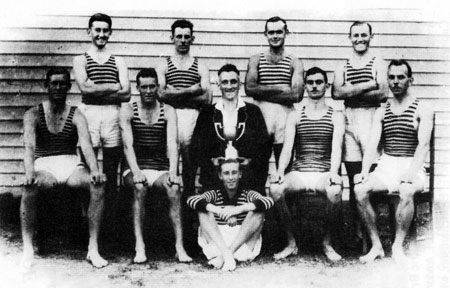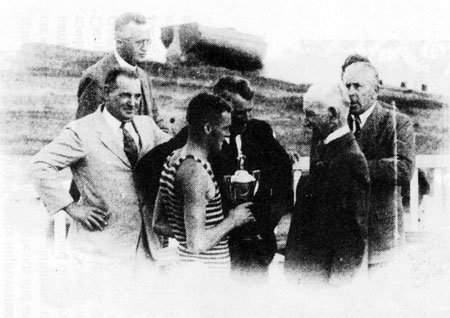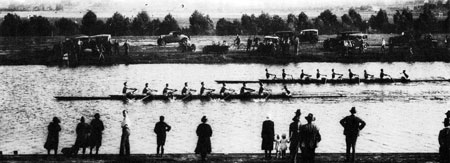History of Barwon Rowing Club
Chapter 6 - To Triumph Untarnished 1920-1944
By the middle of the 1930s the worst was over. However, membership at Barwon had dropped to only 28, and so an association with the Gordon College was forged. Rowing was heavily promoted via the local press and by broadcasting by "Leander" over the new 3GL. Membership was eventually increased by this campaign and by the club's successful "Learn To Row" program.

Scene from the Barwon Regatta
In 1933 the Geelong Town Planning Association conferred with the Geelong Rowing Association over the beautification of the south bank of the river between Princes and Barwon bridges. The town planners wished to plant Lombardy poplars between the road and the river bank, but W. Pincott and Archie Shannon were concerned about the creation of undesirable wind currents affecting crews. Their main complaint was with the growth of reeds along the bank which had to be cut six or seven times a year. Another member of the Geelong Rowing Association, Dr. Moreton had heard that swans had destroyed many of the reeds in the Connewarre Lakes and suggested that some young swans be transferred to the river.
In October, 1935, H. F. Richardson died aged 80 years. An ex-Mayor of Geelong he was also instrumental in the founding of the Great Ocean Road, the new Barwon bridge and a keen supporter of the proposals to open the Barwon River for pleasure steamers. In 1936 the shed was repainted and by 1937 the club had fully recovered as the building fund overdraft was finally paid out and membership was increasing. That year the club won the Lightweight Maiden Four at Ballarat and Barwon regattas with a crew of M. Dunstan (st), P. Roadknight, A. Craggs, R. Sweetten, I. Buchanan, cox and coach A. Renshaw and the Junior Four at Ballarat Regatta, their best season in ten years. The 1937 Barwon Regatta saw a number of changes. The Richardson Reserve was available to the public for the first time upon payment of an entrance fee which ensured a view of the finish, now moved to the west of the bridge. The races were also for the first time started from the bank instead of a small boat moored midstream.
With winning crews, a fine clubhouse and the administration of the sport now controlled by the equal representation of all clubs on the Geelong Rowing Association, the future looked promising. But the dark clouds were gathering again.

Scene from the Barwon Regatta
In September 1939, rushed through both houses of the Victorian Parliament as the government sought to clear all outstanding bills upon the declaration of war, the Barwon River Improvement Bill 1939 vested that portion of the Barwon River between the western boundary of the City of Newtown and the eastern boundary of the City of Geelong, a length of approximately 10 kilometres, in the control of the Geelong Waterworks and Sewerage Trust. The powers conferred by that Act permitted the Trust to charge a river rate and borrow money, deepen, widen and straighten and alter the bed, banks and channel of the river and to carry out general river improvement works. An assurance that the Geelong Waterworks and Sewerage Trust would do everything in its power to improve the river was given by the chairman, Mr. J. McCabe Doyle, a former secretary and current vice-president of the Barwon Rowing Club. Mr. Doyle recognised the Barwon as a national asset and undertook to make thorough investigations to ascertain the most modern and efficient method of removing reeds.
Throughout the first war, despite the large numbers of enlistments, the club had continued to function. Officially all regattas were cancelled but maiden events at various locations were sanctioned; Barwon won the Maiden Eight at Colac Regatta in 1916. The sport was encouraged and kept alive with an eye to the future. This second world war was different. All rowing ceased and most of the country clubs closed their doors. The 14 metropolitan clubs, in 1943, totalled 460 financial members, but the only country rowers were 17 at Ballarat and Ballarat City rowing clubs. The other 19 country clubs reported to the Victorian Rowing Association no financial members. At Barwon's 70th annual general meeting in 1940 it was noted that although several members had been prevented from rowing because of military training or enlistment for service abroad, the activities of the club would continue, although in a much restricted form. The shortage of active rowers throughout Victoria had led the VRA to abandon all championship and premiership races for the duration of the war. Barwon's membership stood at 24, down from the 39 of the previous year. Eighteen club members enlisted: L. Coleman, N. Cochrane, D. Davies, A. Duffield, A. Firth, N. Fitts, D. E. Guye, J. Horton, L. Hagan, E. Mann, Ross Matthews, Ron Matthews, W. E. Meyer, D. McGee, S. McGee, S. McDonald, P. Roadknight and F. Roadknight. Of these, L. Coleman was killed in action, D. McGee was reported missing and F. Roadknight died on service overseas. Of former members, G. E. Searle, who with his three brothers had transferred to Corio Bay in 1938 and of whom all enlisted, was killed.
In 1941 the Geelong Waterworks and Sewerage Trust released plans to straighten the rowing course, but wartime shortages of personnel and materials delayed the work. Barwon's clubhouse also remained unaltered for many years as a result of shortages. In 1944 the club had a membership of 12, half of whom were either life members or vice-presidents. Of the young men, only Bill Grose, A. Baker, P. Craggs, M. Dunstan, I. Rea and Lex Quinn remained. Somehow the sheds and boats were maintained; Bill Grose would open up on weekends to sweep and dust. The club and the river waited for the men to return.

Barwon Regatta 1930s
